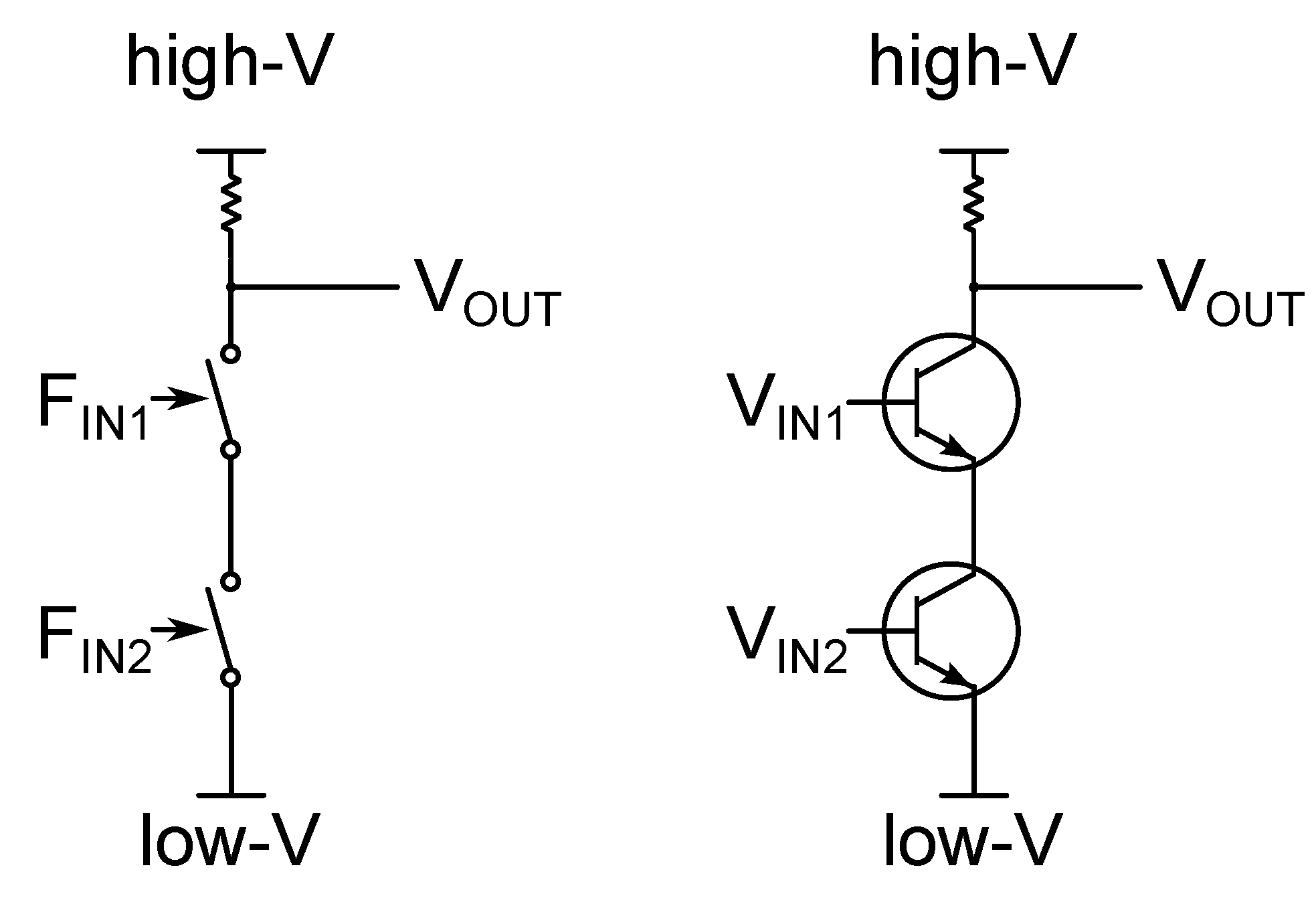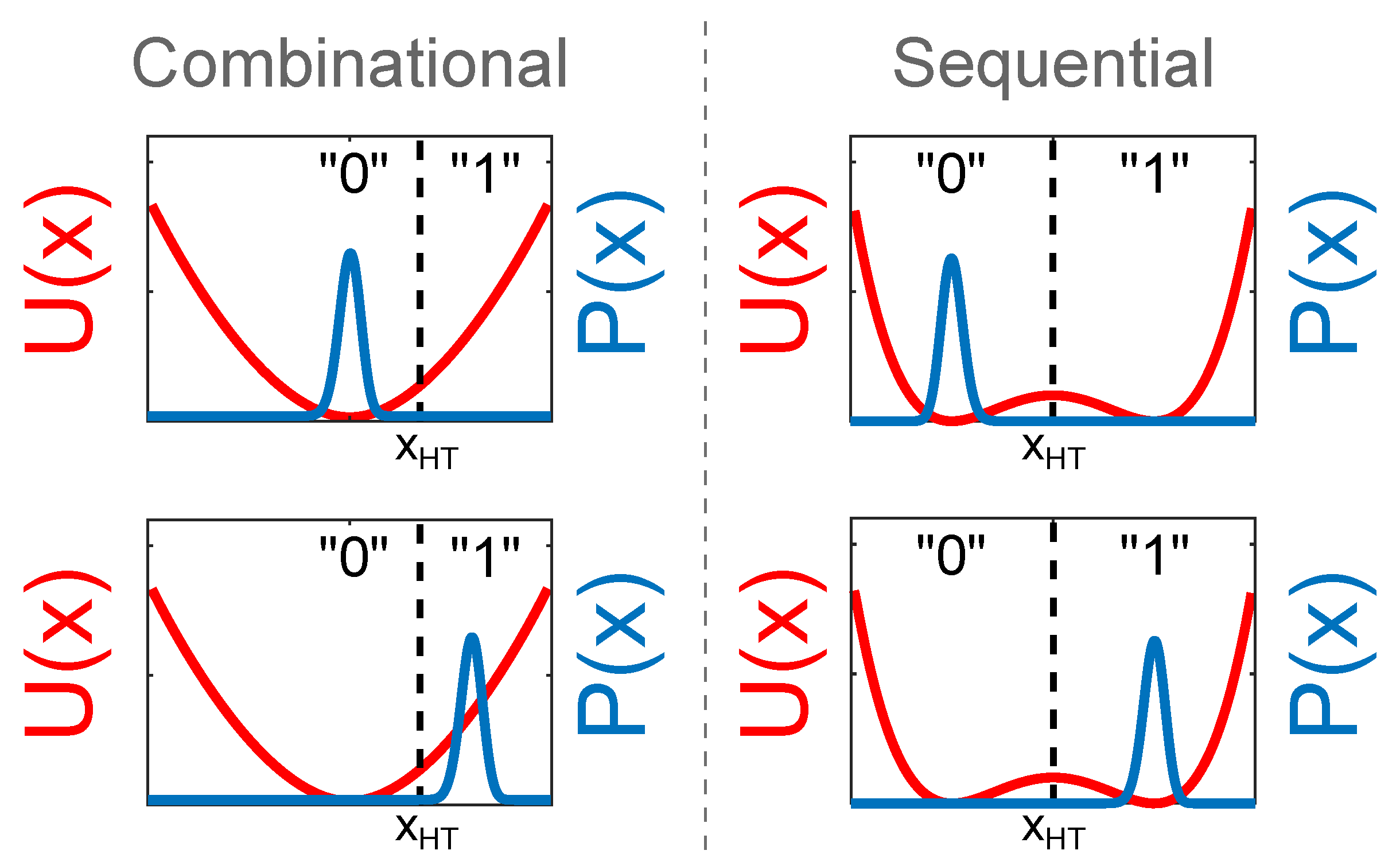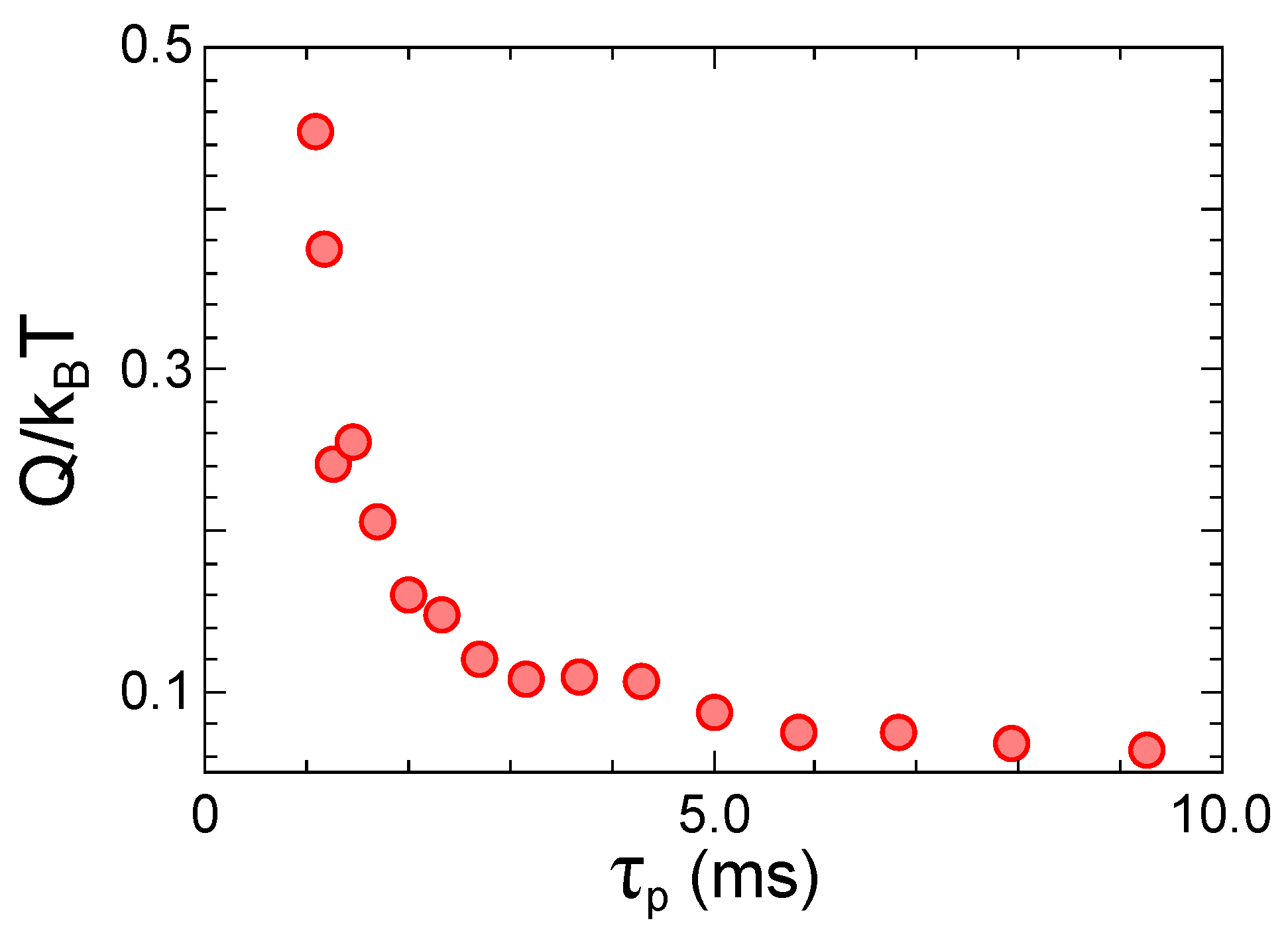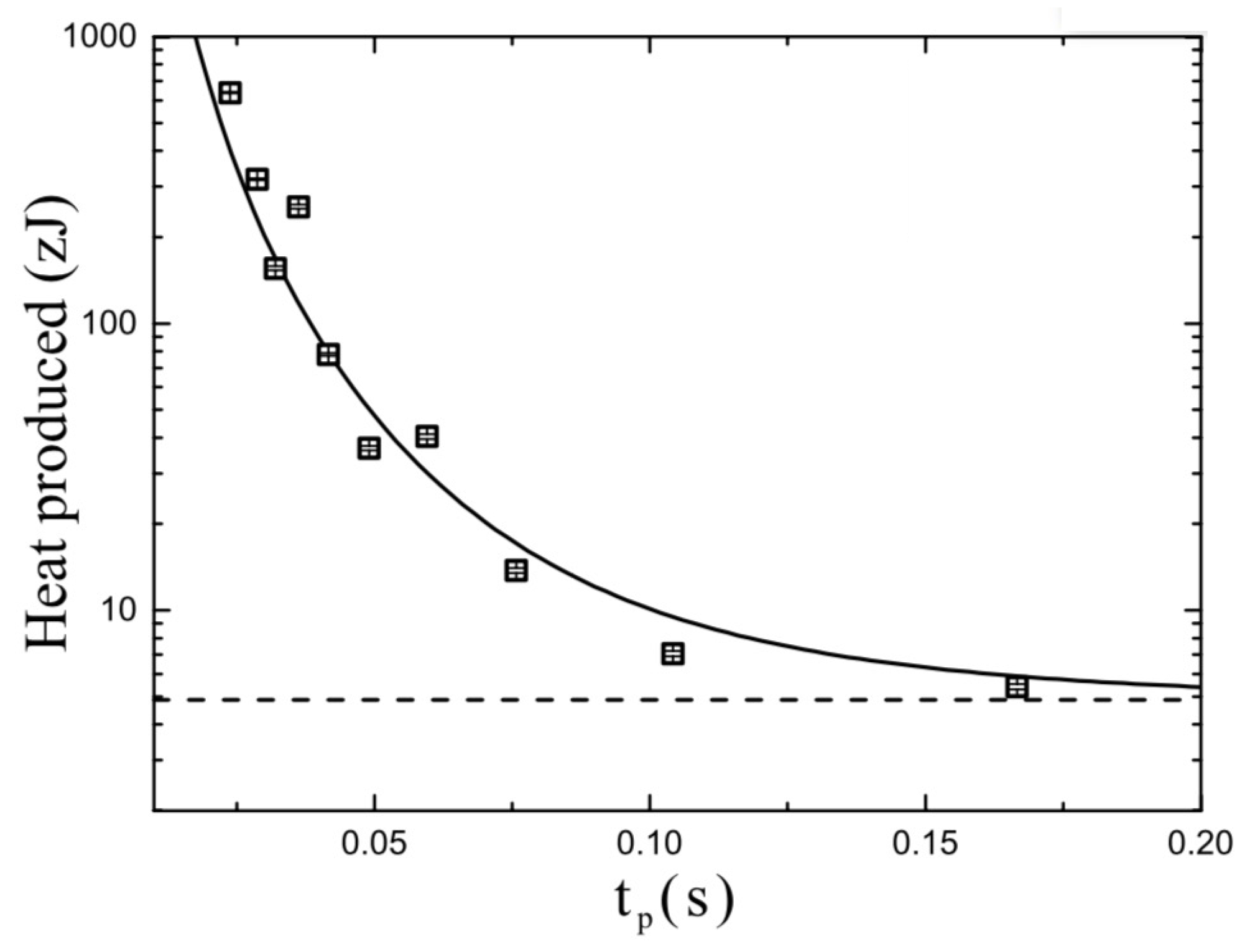Fundamental Limits in Dissipative Processes during Computation
Abstract
1. Introduction
2. Binary Switches
2.1. Energy Dissipation in Charge-Based Switch Devices
2.2. The Physics of Binary Switches
3. Fundamental Energy Limits in Binary Switches
3.1. Combinational Switches and Logic Gates
3.2. Sequential Switches and Memory Devices
3.2.1. The Reset Operation
3.2.2. The Switch Operation
3.2.3. Memory Preservation
4. Conclusions
Author Contributions
Funding
Conflicts of Interest
References
- Welser, J.J.; Bourianoff, G.I.; Zhirnov, V.V.; Cavin, R.K., III. The Quest for the Next, Information Processing Technology. J. Nanopart. Res. 2008, 10, 3. [Google Scholar] [CrossRef]
- Fagas, G.; Gallagher, J.P.; Gammaitoni, L.; Paul, D.J. Energy Challenges for ICT. In ICT— Energy Concepts for Energy Efficiency and Sustainability; IntechOpen: London, UK, 2017; p. 1. [Google Scholar]
- Zhirnov, V.; Cavin, R.; Gammaitoni, L. Minimum Energy of Computing, Fundamental Considerations. In ICT-Energy-Concepts Towards Zero-Power Information and Communication Technology; IntechOpen: London, UK, 2014; p. 139. [Google Scholar]
- Porod, W. The Thermodynamics of Computation: A Contradiction. In Energy Limits in Computation; Springer: Berlin, Germany, 2018; pp. 141–154. [Google Scholar]
- Shannon, C.E. A Mathematical Theory of Communication. Bell Syst. Tech. J. 1948, 27, 379–423. [Google Scholar] [CrossRef]
- Landauer, R. Irreversibility and Heat Generation in the Computing Process. IBM J. Res. Dev. 1961, 5, 183–191. [Google Scholar] [CrossRef]
- Parrondo, J.M.R.; Horowitz, J.M.; Sagawa, T. Thermodynamics of information. Nat. Phys. 2015, 11, 131–139. [Google Scholar] [CrossRef]
- Kaushik, R.; Seng, Y.K. Low Voltage, Low Power VLSI Subsystems; McGraw-Hill Professional: New York, NY, USA, 2004; Figure 2.1; p. 44. [Google Scholar]
- Gardiner, C.W. Handbook of Stochastic Methods; Springer: Berlin, Germany, 1985. [Google Scholar]
- Muratore-Ginanneschi, P.; Schwieger, K. How nanomechanical systems can minimize dissipation. Phys. Rev. E 2014, 90, 060102-5. [Google Scholar] [CrossRef] [PubMed]
- López-Suárez, M.; Neri, I.; Gammaitoni, L. Sub-kBT micro-electromechanical irreversible logic gate. Nat. Commun. 2016, 7, 12068. [Google Scholar] [CrossRef] [PubMed]
- Gammaitoni, L.; Chiuchiú, D.; Madami, M.; Carlotti, G. Towards zero-power ICT. Nanotech 2015, 26, 222001. [Google Scholar] [CrossRef] [PubMed]
- Laplante, P.A. Comprehensive Dictionary of Electrical Engineering; CRC Press: Boca Raton, FL, USA, 2005. [Google Scholar]
- Chiuchiú, D.; López-Suárez, M.; Neri, I.; Diamantini, M.C.; Gammaitoni, L. Cost of remembering a bit of information. Phys. Rev. A 2018, 97, 052108. [Google Scholar] [CrossRef]
- Schmiedl, T.; Seifert, U. Optimal Finite-Time Processes In Stochastic Thermodynamics. Phys. Rev. Lett. 2007, 98, 108301. [Google Scholar] [CrossRef] [PubMed]
- Gomez-Marin, A.; Schmiedl, T.; Seifert, U. Optimal protocols for minimal work processes in underdamped stochastic thermodynamics. J. Chem. Phys. 2008, 129, 024114. [Google Scholar] [CrossRef] [PubMed]
- Aurell, E.; Mejia-Monasterio, C.; Muratore-Ginanneschi, P. Optimal Protocols and Optimal Transport in Stochastic Thermodynamics. Phys. Rev. Lett. 2011, 106, 250601. [Google Scholar] [CrossRef] [PubMed]
- Muratore-Ginanneschi, P.; Schwieger, K. An Application of Pontryagin’s Principle to Brownian Particle Engineered Equilibration. Entropy 2017, 19, 379. [Google Scholar] [CrossRef]
- Strategic Research Agenda. ICT-Energy Consortium. 2016. Available online: www.ict-energy.eu/sites/ict-energy.eu/files/ICTEnergySRA_0.pdf (accessed on 1 May 2019).






© 2019 by the authors. Licensee MDPI, Basel, Switzerland. This article is an open access article distributed under the terms and conditions of the Creative Commons Attribution (CC BY) license (http://creativecommons.org/licenses/by/4.0/).
Share and Cite
Chiucchiú, D.; Diamantini, M.C.; López-Suárez, M.; Neri, I.; Gammaitoni, L. Fundamental Limits in Dissipative Processes during Computation. Entropy 2019, 21, 822. https://doi.org/10.3390/e21090822
Chiucchiú D, Diamantini MC, López-Suárez M, Neri I, Gammaitoni L. Fundamental Limits in Dissipative Processes during Computation. Entropy. 2019; 21(9):822. https://doi.org/10.3390/e21090822
Chicago/Turabian StyleChiucchiú, Davide, Maria Cristina Diamantini, Miquel López-Suárez, Igor Neri, and Luca Gammaitoni. 2019. "Fundamental Limits in Dissipative Processes during Computation" Entropy 21, no. 9: 822. https://doi.org/10.3390/e21090822
APA StyleChiucchiú, D., Diamantini, M. C., López-Suárez, M., Neri, I., & Gammaitoni, L. (2019). Fundamental Limits in Dissipative Processes during Computation. Entropy, 21(9), 822. https://doi.org/10.3390/e21090822





